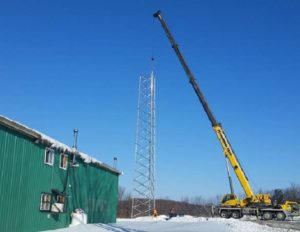Alderville’s latest addition connects the community

By Rick Garrick
ALDERVILLE FIRST NATION—Alderville First Nation recently installed a 200-foot-high communications tower to provide wireless Internet service to community members through a band-owned Internet service company.
“Everyone is excited,” says Alderville Chief James R. Marsden. “Our idea was to get into the business as an Internet service provider for our community offering better rates for community members of Alderville First Nation, but [also to] expand outside the reserve boundary into the townships and offer a full-service to the surrounding area.”
Marsden says the wireless Internet service will be good for any businesses that set up in the community.
“For blueprints or anything like that, it will be just so fast,” Marsden says. “I sent out an update from my office to any members thinking of switching to other [Internet] companies to just hold off. We’ll have our own running and then you can just support your own company.”
Marsden says the company will be 100 per cent owned by Alderville First Nation.
“We ordered the fiber-optic through Bell and the radios will be going up with the antennas hopefully by the end of April,” Marsden says. “We sent out [a request for proposal] to get a company onsite for radio and antenna recommendations and training on installations, setup and operations of an Internet service system. It’s going to be wireless, but eventually we would like to go fiber-optic to each of our homes in the future.”
Marsden says a fiber-optic cable is already installed along the highway through the community, so it would only require the installation of fiber-optic lines from the main cable to the homes to connect them. The band negotiated to have five office buildings connected to the fiber-optic network when it was installed through the community’s traditional territory beginning in 2010.
“Once we start making plans for [connecting homes with fiber-optic] in a couple of years, we’ll make better use of those lines,” Marsden says.
Marsden says the wireless Internet service will be provided through the use of antennas that will be installed on the homes of community members. He adds that the company will need to hire installers, marketing and finance people, and IT people to service calls from customers.
“In the country or rural areas, it’s usually wireless and you are bouncing from antenna to antenna for service,” Marsden says, noting that his community is located on hilly terrain in Northumberland County. “We’re all spread out. We’ve got a few small subdivisions, but we’re spread out over the [band’s] 3,000 acres.”
Marsden says the service could also be offered to Hiawatha First Nation, which is located on the north side of Rice Lake. Alderville is located on south side of Rice Lake.
“If we could put a tower there, we could also supply them,” Marsden says. “In our business plan that we provided to [Indigenous and Northern Affairs Canada], there was room for at least three towers to get us rolling.”
Marsden says an early addition to the project also includes a Voice over Internet Protocol (VoIP) phone service for the band offices and community members.
“We did our study and the band was paying $2,500 a month for all of our administration buildings,” Marsden says. “Running our own service through the (VoIP), it would be about $500. That’s how much alone the First Nation will be saving each month.”
The federal government funded the project with about $43,693 during the current fiscal year and about $198,165 in the following fiscal year.


